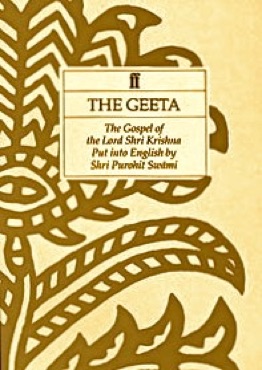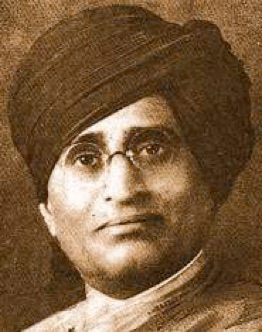Ashtanga Yoga Bangkok

The Gospel of the Lord Shri Krishna Put into English by Shri Purohit Swami
Shri Purohit Swami, an Indian mystic and poet whose work was much admired by W.B. Yeats, first published his translation of The Geeta in the 1930s. It remains the finest interpretation of the text for a Western audience, a beautiful rendering of the original into English which conveys a clearer and more truthful impression of what the Indian reader takes it to mean than a literal translation would do.
A NOTE ABOUT THE TRANSLATOR
Shri Purohit Swami was born into a religious and wealthy family in Badners, India, in 1882. He studied philosophy and law, received his LL.B. from Decan College, Poona, married and had three children. However, he did not practice law, and instead spent his entire life in spiritual devotion. He wrote in his native Marathi, in Hindi, Sanskrit and English – poems, songs, a play, a novel, a commentary on The Bhagavad Gita and an autobiography. He left India in 1930 at the suggestion of his Master to interpret the religious life of India for the West, and made his new home in England. It was here that he produced beautiful translations of The Bhagavad Gita, Patanjali’s Aphorisms of Yoga and – in collaboration with his great friend, the Irish poet W.B. Yeats – The Ten Principal Upanishads. He died in 1946.

The Bhagavad Gita

PREFACE
The Bhagavad Gita, the greatest devotional book of Hinduism, has long been recognized as one of the world’s spiritual classics and a guide to all on the path of Truth. It is sometimes known as the Song of the Lord or the Gospel of the Lord Shri Krishna. According to Western scholarship, it was composed later than the Vedas and the Upanishads – probably between the fifth and second centuries before Christ. It is a fragment, part of the sixth book of the epic poem The Mahabaratha.
The Mahabaratha tells of the Pandavas, Prince Arjuna and his four brothers, growing up in north India at the court of their uncle, the blind King Dhritarashtra, after the death of their father, the previous ruler. There is always great rivalry between the Pandavas or sons of Pandu and the Kauravas, the one hundred sons of Dhritarashtra. Eventually the old king gives his nephews some land of their own but his eldest son, Duryodhana, defeats Yudhisthira, the eldest Pandava, by cheating at dice, and forces him and his brothers to surrender their land and go into exile for thirteen years. On their return, the old king is unable to persuade his son Duryodhana to restore their heritage and, in spite of efforts at reconciliation by Sanjaya, Dhritarashtra’s charioteer; by Bheeshma, his wise counsellor; and even by the Lord Krishna himself, war cannot be averted. The rival hosts face each other on the field of Kurukshetra. It is at this point that The Bhagavad Gita begins.
When Prince Arjuna surveys the battlefield, he is overwhelmed with sorrow at the futility of war. The teachings of The Bhagavad Gita are spoken by the divine Lord Krishna, who is acting as the prince’s charioteer. They are overheard by Sanjaya and reported back to King Dhritarashtra. When Krishna has finished speaking to Arjuna, the two armies engage. The battle lasts eighteen days and by the end of it nearly all of the warriors on both sides are dead save Krishna and the five sons of Pandu.
From Wikepedia - Bhagavad Gita :
The Bhagavad Gītā (Sanskrit: भगवद्गीता, IPA: [ˈbʱəɡəʋəd̪ ɡiːˈt̪aː], Song of God), also more simply known as Gita, is a 700-verse Hindu scripture that is part of the ancient Hindu epic, the Mahabharata, but is frequently treated as a freestanding text, and in particular, as an Upanishad in its own right, one of the several books that comprise the more general Vedic tradition. It is a very comprehensive compendium of the whole Vedic tradition, and an introduction to the text states that the book is considered among the most important texts in the history of literature and philosophy. The teacher of the Bhagavad Gita is Lord Krishna, who is revered by Hindus as a manifestation of God (Parabrahman) Himself, and is referred to within as Bhagavan, the Divine One.
The context of the Gita is a conversation between Lord Krishna and the Pandava prince Arjuna taking place on the battlefield before the start of the Kurukshetra War. Responding to Arjuna's confusion and moral dilemma about fighting his own cousins who command a tyranny imposed on a captured State, Lord Krishna explains to Arjuna his duties as a warrior and prince, and elaborates on different Yogic and Vedantic philosophies, with examples and analogies. This has led to the Gita often being described as a concise guide to Hindu theology and also as a practical, self-contained guide to life. During the discourse, Lord Krishna reveals His identity as the Supreme Being Himself (Svayam Bhagavan), blessing Arjuna with an awe-inspiring vision of His divine universal form.
The direct audience to Lord Krishna’s discourse of the Bhagavad Gita included Arjuna (addressee), Sanjaya (using Divya Drishti (or divine vision) gifted by the sage Veda Vyasa to watch the war and narrate the events to Dhritarashtra), Lord Hanuman (perched atop Arjuna’s chariot) and Barbarika, son of Ghatotkacha, who also witnessed the complete 18 days of action at Kurukshetra.
The Bhagavad Gita is also called Gītopaniṣad, implying its having the status of an Upanishad, i.e. a Vedantic scripture. Since the Gita is drawn from the Mahabharata, it is classified as a Smṛiti text. However, those branches of Hinduism that give it the status of an Upanishad also consider it a śruti or "revealed" text. As it is taken to represent a summary of the Upanishadic teachings, it is also called "the Upanishad of the Upanishads". Another title is mokṣaśāstra, or "Scripture of Liberation".
It has been highly praised by not only prominent Indians such as Mohandas Karamchand Gandhi but also Aldous Huxley, Albert Einstein, J. Robert Oppenheimer, Ralph Waldo Emerson, Carl Jung and Herman Hesse.